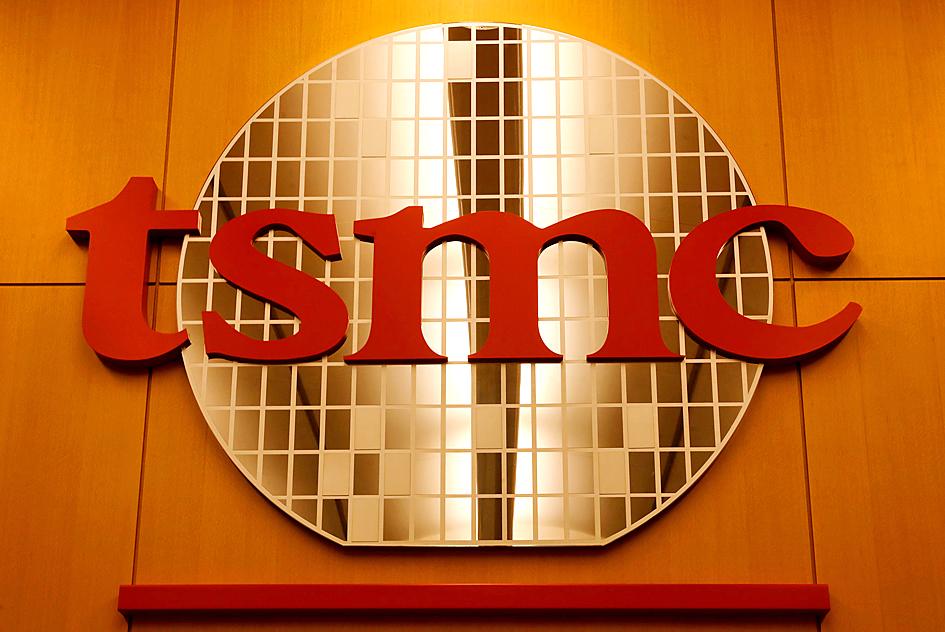Taiwan Semiconductor Manufacturing Co (TSMC, 台積電) reported that the US last year approved 99 percent of its patent applications, which placed the tech giant among the top patent holders in the US.
In its Corporate Social Responsibility Report, TSMC said it last year secured about 3,600 patents worldwide, including more than 2,300 in the US.
As of the end of last year, TSMC owned more than 39,000 patents, the report said.

Photo: Reuters
The company last year filed almost 6,500 patent applications worldwide and ranked among the top 10 patent applicants in the US. In Taiwan, it was the largest patent applicant for the fourth consecutive year.
As of the end of last year, TSMC had filed more than 55,000 patent applications worldwide.
The chipmaker, which has a more than 50 percent share of the world’s pure wafer foundry business, said that to protect its intellectual property, maintain a lead over its peers and boost its competitive edge, it is determined to strengthen its intellectual property portfolio.
Also in the report, TSMC said it last year spent US$2.96 billion on research and development (R&D), a new high in the company’s history.
Last year’s R&D spending rose 4 percent from a year earlier, with its R&D workforce growing 5 percent to 6,534.
The expenses amounted to about 8.5 percent of TSMC’s total sales last year.
The company has said it expects its R&D spending would equal 8.5 percent of its annual revenue until 2030.
TSMC reported record-high sales last year of NT$1.07 trillion, and forecast that sales this year would grow 14 to 19 percent, so its R&D spending is expected to reach another high, ranging between US$3.37 billion and US$3.52 billion.
Analysts said that TSMC’s R&D spending is the reason the chipmaker over the past few years has been able to serve as the sole processor provider to Apple Inc for iPhone production.
Through its R&D efforts, TSMC has also secured large orders from HiSilicon Technologies Co (海思半導體) — an integrated circuit design unit of Chinese telecom equipment supplier Huawei Technologies Co (華為) — and US clients such as Advanced Micro Devices Inc, Nvidia Corp and Qualcomm Inc, as well as Taiwanese IC designer MediaTek Inc (聯發科), analysts said.
Analysts also said that TSMC not only leads South Korean rival Samsung Electronics Co, but has also left its Chinese competitor Semiconductor Manufacturing International Corp (中芯國際) about two generations behind.

JITTERS: Nexperia has a 20 percent market share for chips powering simpler features such as window controls, and changing supply chains could take years European carmakers are looking into ways to scratch components made with parts from China, spooked by deepening geopolitical spats playing out through chipmaker Nexperia BV and Beijing’s export controls on rare earths. To protect operations from trade ructions, several automakers are pushing major suppliers to find permanent alternatives to Chinese semiconductors, people familiar with the matter said. The industry is considering broader changes to its supply chain to adapt to shifting geopolitics, Europe’s main suppliers lobby CLEPA head Matthias Zink said. “We had some indications already — questions like: ‘How can you supply me without this dependency on China?’” Zink, who also

The number of Taiwanese working in the US rose to a record high of 137,000 last year, driven largely by Taiwan Semiconductor Manufacturing Co’s (TSMC, 台積電) rapid overseas expansion, according to government data released yesterday. A total of 666,000 Taiwanese nationals were employed abroad last year, an increase of 45,000 from 2023 and the highest level since the COVID-19 pandemic, data from the Directorate-General of Budget, Accounting and Statistics (DGBAS) showed. Overseas employment had steadily increased between 2009 and 2019, peaking at 739,000, before plunging to 319,000 in 2021 amid US-China trade tensions, global supply chain shifts, reshoring by Taiwanese companies and

Taiwan Semiconductor Manufacturing Co (TSMC, 台積電) received about NT$147 billion (US$4.71 billion) in subsidies from the US, Japanese, German and Chinese governments over the past two years for its global expansion. Financial data compiled by the world’s largest contract chipmaker showed the company secured NT$4.77 billion in subsidies from the governments in the third quarter, bringing the total for the first three quarters of the year to about NT$71.9 billion. Along with the NT$75.16 billion in financial aid TSMC received last year, the chipmaker obtained NT$147 billion in subsidies in almost two years, the data showed. The subsidies received by its subsidiaries —

At least US$50 million for the freedom of an Emirati sheikh: That is the king’s ransom paid two weeks ago to militants linked to al-Qaeda who are pushing to topple the Malian government and impose Islamic law. Alongside a crippling fuel blockade, the Group for the Support of Islam and Muslims (JNIM) has made kidnapping wealthy foreigners for a ransom a pillar of its strategy of “economic jihad.” Its goal: Oust the junta, which has struggled to contain Mali’s decade-long insurgency since taking power following back-to-back coups in 2020 and 2021, by scaring away investors and paralyzing the west African country’s economy.